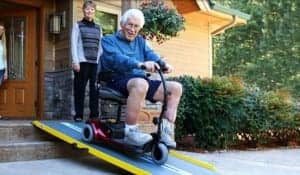The New York Times, on August 13, 2009, published the following article about an injured soldier who transformed a wartime disability into an asset:
By ALAN SCHWARZ
The decision came only days after Jerrod Fields, a United States Army corporal on a 2005 reconnaissance mission in Baghdad, had his left ankle and foot mutilated by a roadside bomb. After managing to drive his four troopmates back to base — valor that earned him a Bronze Star — Fields woke up in a hospital in Germany with a choice: have surgery and be discharged, or amputate and stay a soldier.
But the next medal Fields accepts could come in London. Four years after taking his first tentative steps on a prosthetic foot, Fields now sprints so fast that he is considered a top United States prospect for the 2012 Paralympic Games — someone who just might knock off Oscar Pistorius of South Africa.
Fields belongs to the Army’s World Class Athlete Program, which allows soldiers to train for the Olympics and the Paralympics while on active duty. Trading Army green for Paralympic red, white and blue would cap Fields’s rise from Chicago-project orphan and gang hopeful to hero soldier and elite athlete.
To read the entire story, click here.
Fields became a fringe member of the Gansta Disciples but focused enough on sports and school to attend Tennessee State University for two years. He then enlisted in the Army and was deployed to Iraq in January 2005. A month later, reports of a dead dog on a Baghdad road — animal carcasses were often booby-trapped with explosives — led his platoon to drive in to investigate.
The dog itself was harmless, but still a trap. A small bomb went off nearby. Fields laughed; he thought he had dropped a grenade. Then another explosion destroyed his lower left leg.
Fields kept his wits enough to drive his Bradley armored vehicle and fellow troops out of danger. But when he eventually came to in a hospital in Germany, he was so disoriented that he tried to choke his nurse. Doctors explained what had happened, and told Fields they could rebuild his leg by grafting muscle and fusing his ankle
Indeed, Fields acclimated to a prosthetic foot so quickly that he found himself barely missing the real one. He ran swiftly and even did standing backflips. Fields had never heard of the Paralympics at that point, but a fellow soldier suggested that he apply to the World Class Athlete Program. Two days before being redeployed to Iraq in August 2007 — he had worked himself back into combat shape — Fields was accepted and immediately stunned his new coach, Al Joyner.
Within a year, Fields was running 100 meters in 12 seconds flat. Running that fast on a Cheetah foot, a long, carbon-fiber blade that mimics the spring and power of the human lower leg, required Fields to understand the unique demands of amputee sprinting. His hip flexors had to learn to balance legs of different weights and feet of different lengths. The nerve receptors in the stump below his knee had to figure out how to sense the track beneath his artificial foot.
Decreasing his time to 11.2 or 11.3 seconds, which would get him to the Games, will be even harder than running 12 this soon, Marlon Shirley, a two-time gold medalist in the Paralympic 100 meters who also trains in Chula Vista warned. But the top United States sprinter Brian Frasure has retired, and Shirley has sustained major knee and Achilles’ tendon injuries. So Fields and the Paralympic veteran Jerome Singleton could become the top United States hopes to run an 11.1 or lower, which could beat Pistorius, a double-amputee who runs so fast on two Cheetah feet that he almost qualified for the Olympic 400 meters.
Joyner said Fields could ultimately run faster than Shirley — the most decorated United States track-and-field Paralympian — in his prime. Shirley said that was possible, too, if Fields could learn the nuances of top-caliber sprinting and then perform in now-or-never competition. The indoor season begins next month.
To read the entire story, click here.
[Source: New York Times]


